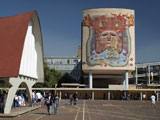Friday, April 26, 2024
News and Views from the Global South

Mexico's Future Hinges on Near-Empty Science Classrooms
- The suspension of classes in Mexico due to the swine flu epidemic is not the only reason science and technology university courses have been nearly deserted.
Until recently, Armando Guadarrama attended a class with just 15 students, but now “we joined with another group because we were so few, and now there are about 30,” he said.
Guadarrama is in his eighth semester of petro-chemical engineering at the National Polytechnic Institute (IPN) in Mexico City, and is enthusiastic about his future profession: “I would like to conduct research to improve refining processes so that they pollute the atmosphere less.”
Although petroleum provides Mexico with 10 percent of its gross domestic product (GDP), it is among many academic fields — mostly science and technology — ignored by young people in Mexico.
The other side of the story is the traditional fields, where students have filled university classrooms for decades: medicine, accounting, law, tourism, design, psychology, business administration, communication, architecture and dentistry.
With graphs in hand, David Jaramillo, IPN's director of higher education, explains “this year 28 students competed for each of our openings in medicine.” In comparison, for each spot in petro-chemical engineering, fewer than five competed.
Antonio Aguilar is information coordinator for another of the country's most important universities, the Autonomous Metropolitan University (UAM). There, the 10 most popular fields of study account for 52 percent of the student demand.
“It's sad, because we offer 79 areas of study. In other words, the 69 remaining fight for the 48 percent of the demand,” he said.
There's a reason for the half-deserted classrooms: “When I go to chat with aspiring students, I conduct an exercise. I ask them to name 10 fields of study, but they have a hard time coming up with eight. There is total ignorance,” he said.
Guadarrama admits that his choice did not involve vocational guidance. “I have an uncle that works in this, that's why I knew about it,” he explains.
His is not an isolated case. When officials from the three federal universities of the Mexican capital discuss matters, “the surprise is that it's the same situation. We are low in demand for sciences and technology,” said Aguilar.
And this situation “is a melting pot of what is happening in all Mexico,” where just 0.4 percent of the GDP is invested in science and technology.
It is strange, says Aguilar, that in “a country with the Pacific Ocean and the Gulf of Mexico, with their great marine wealth, nobody wants to study marine biology.”
“We have the most intense tides in the world, the northern hemisphere's most important solar radiation zones, and we are full of petroleum — that is now running out — and it's a shame that energy engineering is not a high-demand field,” he said.
In a country “where the south is drowning because the rivers flood, while in the north we are dying of thirst, nobody wants to study hydrology engineering.”
Mexico needs more technicians, researchers and scientists in order to confront such pressing problems as global climate change.
“Climate change is creating areas of desertification, there are problems of rural productivity, and there are not enough professionals to come up with solutions,” says Roberto Rodríguez, an official at the National Autonomous University of Mexico (UNAM).
Jaramillo points out that Mexico is one of the “leading producers of silver, caolinite, bauxite, cement and glass, but there is no value added to these materials.” At the same time, “all earth sciences, like geology, mining, metallurgy, have problems with demand.”
Without professionals in math and physics, other neglected fields, “we will always have dependent technologies,” says Rodríguez, member of the Mexican Academy of Sciences.
In astronomy, Mexico has made “contributions to the map of the universe and of black holes, which are up to the level of research in the rest of the world. And having astronomers comes from having physics as a field of study,” he said.
There have also been significant Mexican contributions “to the knowledge about coastal zones and farming, and exploitation of mangroves,” thanks to oceanography.
This is why the universities cannot shut down less popular departments, even if it is an effort to attract the minimum number of students to offer the courses.
These fields “offer employment, professional development, niche opportunities. In other countries they are exploding, and here, with 106 million inhabitants, we barely have 15 young people who want to study them,” adds Rodríguez.
Young Guadarrama has hopes. “If you go to the Pemex (Petróleos Mexicanos) page on the Internet, you're going to see that an engineering internship is paying about 20,000 pesos (1,400 dollars), and that's without having the degree,” he says.
Itzel Condado is in the second semester of chemistry at UNAM and believes most of her peers reject her chosen field because “they think they are going to earn more money in other areas, or that there won't be any jobs,” even though “there is a lot of research in 'green' chemistry, processes that help fight pollution,” she says.
Meanwhile, at the other extreme, the traditional areas of study at Mexican universities are seeing record numbers of applicants.
In March, UNAM rector José Narro reported for this year “the highest demand” in the university's history: 114,000 young people took the admission exam, but just eight percent were admitted.
The great number of rejections is a national constant. The university officials explain that the higher education system only has a capacity for 26 of every 100 Mexicans of university age to study.
In addition, Mexico is experiencing a “demographic dividend”, a favorable relationship between the population of dependent age and the population of working age. Historically, the country has had a higher percentage of children, but because of family planning policies in the 1970s, now there are more young adults — a situation that is expected to remain until 2025.
According to the United Nations, Mexico has 16 working age adults for every 10 children or elderly adults. But the benefits of this demographic dividend, warns the UN, are not automatic. To make the most of it, the youth must be educated in order to develop a more highly qualified labor force.
In Aguilar's opinion, the key to filling science and technology classrooms is “through state intervention.”
Scholarship programs are successful in keeping young people studying and at the same time “giving preference to those seeking technological and scientific careers,” he explains.
Condado is one example. She continued studying thanks to a scholarship from the Mexican Academy of Sciences, for having won the National Chemistry Olympics.
But in her class she is one of the few truly interested in this science, she says. “There are 50 students, but many of my classmates are just there because they couldn't get into medicine, and they're the ones who will drop out. In the end just 20 per class graduate.”
Condado believes there needs to be more information touted about laboratory research projects and how they are applicable to everyday life. That would give pause to students who originally chose medicine “because they wanted to save lives.”
“You can save more lives in chemistry than in medicine,” she says, and is ready with an example: “A professor told us that if someone could find a way to convert carbon dioxide into acetic acid (vinegar), we'd solve the problem of global warming.”

 Print
Print




